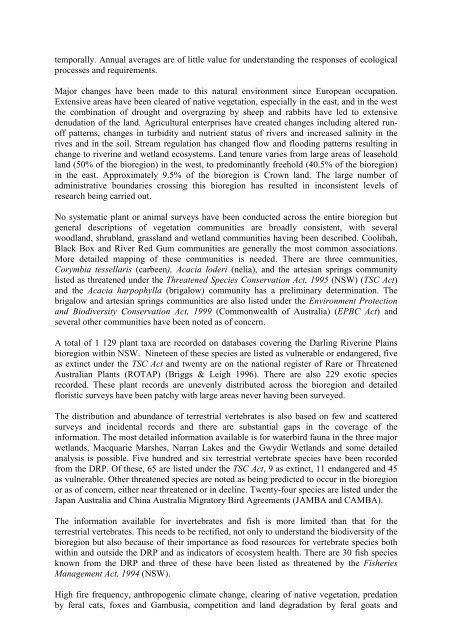DARLING RIVERINE PLAINS BIOREGION Background Report
DARLING RIVERINE PLAINS BIOREGION Background Report
DARLING RIVERINE PLAINS BIOREGION Background Report
Create successful ePaper yourself
Turn your PDF publications into a flip-book with our unique Google optimized e-Paper software.
temporally. Annual averages are of little value for understanding the responses of ecological<br />
processes and requirements.<br />
Major changes have been made to this natural environment since European occupation.<br />
Extensive areas have been cleared of native vegetation, especially in the east, and in the west<br />
the combination of drought and overgrazing by sheep and rabbits have led to extensive<br />
denudation of the land. Agricultural enterprises have created changes including altered runoff<br />
patterns, changes in turbidity and nutrient status of rivers and increased salinity in the<br />
rives and in the soil. Stream regulation has changed flow and flooding patterns resulting in<br />
change to riverine and wetland ecosystems. Land tenure varies from large areas of leasehold<br />
land (50% of the bioregion) in the west, to predominantly freehold (40.5% of the bioregion)<br />
in the east. Approximately 9.5% of the bioregion is Crown land. The large number of<br />
administrative boundaries crossing this bioregion has resulted in inconsistent levels of<br />
research being carried out.<br />
No systematic plant or animal surveys have been conducted across the entire bioregion but<br />
general descriptions of vegetation communities are broadly consistent, with several<br />
woodland, shrubland, grassland and wetland communities having been described. Coolibah,<br />
Black Box and River Red Gum communities are generally the most common associations.<br />
More detailed mapping of these communities is needed. There are three communities,<br />
Corymbia tessellaris (carbeen), Acacia loderi (nelia), and the artesian springs community<br />
listed as threatened under the Threatened Species Conservation Act, 1995 (NSW) (TSC Act)<br />
and the Acacia harpophylla (brigalow) community has a preliminary determination. The<br />
brigalow and artesian springs communities are also listed under the Environment Protection<br />
and Biodiversity Conservation Act, 1999 (Commonwealth of Australia) (EPBC Act) and<br />
several other communities have been noted as of concern.<br />
A total of 1 129 plant taxa are recorded on databases covering the Darling Riverine Plains<br />
bioregion within NSW. Nineteen of these species are listed as vulnerable or endangered, five<br />
as extinct under the TSC Act and twenty are on the national register of Rare or Threatened<br />
Australian Plants (ROTAP) (Briggs & Leigh 1996). There are also 229 exotic species<br />
recorded. These plant records are unevenly distributed across the bioregion and detailed<br />
floristic surveys have been patchy with large areas never having been surveyed.<br />
The distribution and abundance of terrestrial vertebrates is also based on few and scattered<br />
surveys and incidental records and there are substantial gaps in the coverage of the<br />
information. The most detailed information available is for waterbird fauna in the three major<br />
wetlands, Macquarie Marshes, Narran Lakes and the Gwydir Wetlands and some detailed<br />
analysis is possible. Five hundred and six terrestrial vertebrate species have been recorded<br />
from the DRP. Of these, 65 are listed under the TSC Act, 9 as extinct, 11 endangered and 45<br />
as vulnerable. Other threatened species are noted as being predicted to occur in the bioregion<br />
or as of concern, either near threatened or in decline. Twenty-four species are listed under the<br />
Japan Australia and China Australia Migratory Bird Agreements (JAMBA and CAMBA).<br />
The information available for invertebrates and fish is more limited than that for the<br />
terrestrial vertebrates. This needs to be rectified, not only to understand the biodiversity of the<br />
bioregion but also because of their importance as food resources for vertebrate species both<br />
within and outside the DRP and as indicators of ecosystem health. There are 30 fish species<br />
known from the DRP and three of these have been listed as threatened by the Fisheries<br />
Management Act, 1994 (NSW).<br />
High fire frequency, anthropogenic climate change, clearing of native vegetation, predation<br />
by feral cats, foxes and Gambusia, competition and land degradation by feral goats and

















